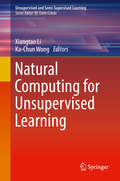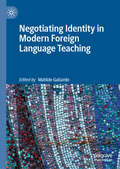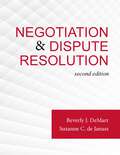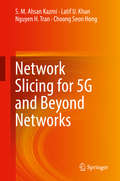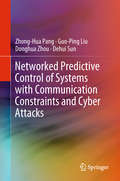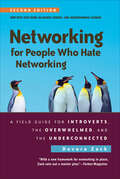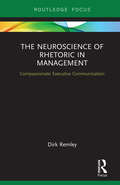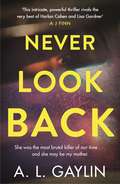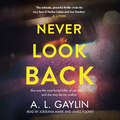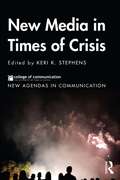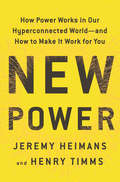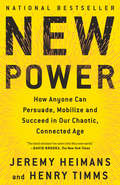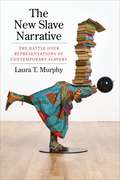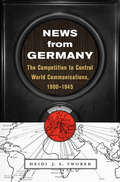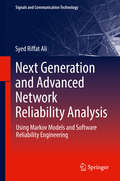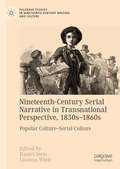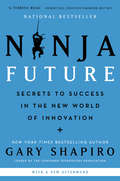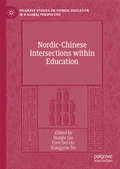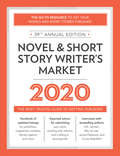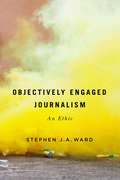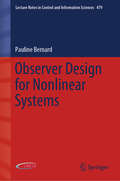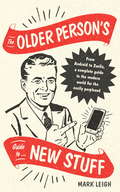- Table View
- List View
Natural Computing for Unsupervised Learning (Unsupervised and Semi-Supervised Learning)
by Xiangtao Li Ka-Chun WongThis book highlights recent research advances in unsupervised learning using natural computing techniques such as artificial neural networks, evolutionary algorithms, swarm intelligence, artificial immune systems, artificial life, quantum computing, DNA computing, and others. The book also includes information on the use of natural computing techniques for unsupervised learning tasks. It features several trending topics, such as big data scalability, wireless network analysis, engineering optimization, social media, and complex network analytics. It shows how these applications have triggered a number of new natural computing techniques to improve the performance of unsupervised learning methods. With this book, the readers can easily capture new advances in this area with systematic understanding of the scope in depth. Readers can rapidly explore new methods and new applications at the junction between natural computing and unsupervised learning. Includes advances on unsupervised learning using natural computing techniquesReports on topics in emerging areas such as evolutionary multi-objective unsupervised learning Features natural computing techniques such as evolutionary multi-objective algorithms and many-objective swarm intelligence algorithms
Negotiating Identity in Modern Foreign Language Teaching
by Matilde GallardoThis edited book examines modern foreign language teachers who research their own and others’ experiences of identity construction in the context of living and teaching in UK institutions, primarily in the Higher Education sector. The book offers an insight into a key element of the educational and socio-political debate surrounding MFL in the UK: the teachers’ voices and their sense of agency in constructing their professional identities. The contributors use a combination of empirical research and personal reflection to generate knowledge about MFL teachers’ identity that can enhance how they are perceived in the social and educational establishments and raise awareness of key issues affecting the profession. This book will be of particular interest to language teachers, teacher trainers, applied linguists and students and scholars of modern foreign languages.
Negotiation & Dispute Resolution
by Beverly J. DeMarr Suzanne de JanaszFormerly published by Chicago Business Press, now published by Sage Negotiation and Dispute Resolution, Second Edition utilizes an applied approach to covering basic negotiation concepts while highlighting a broad range of topics on the subject. Authors Beverly J. DeMarr and Suzanne C. de Janasz help students develop the ability to successfully negotiate and resolve conflicts in a wide variety of situations in both their professional and personal lives.
Negotiation & Dispute Resolution
by Beverly J. DeMarr Suzanne de JanaszFormerly published by Chicago Business Press, now published by Sage Negotiation and Dispute Resolution, Second Edition utilizes an applied approach to covering basic negotiation concepts while highlighting a broad range of topics on the subject. Authors Beverly J. DeMarr and Suzanne C. de Janasz help students develop the ability to successfully negotiate and resolve conflicts in a wide variety of situations in both their professional and personal lives.
Network Slicing for 5G and Beyond Networks
by S. M. Kazmi Latif U. Khan Nguyen H. Tran Choong Seon HongThis book provides a comprehensive guide to the emerging field of network slicing and its importance to bringing novel 5G applications into fruition. The authors discuss the current trends, novel enabling technologies, and current challenges imposed on the cellular networks. Resource management aspects of network slicing are also discussed by summarizing and comparing traditional game theoretic and optimization based solutions. Finally, the book presents some use cases of network slicing and applications for vertical industries. Topics include 5G deliverables, Radio Access Network (RAN) resources, and Core Network (CN) resources. Discusses the 5G network requirements and the challenges therein and how network slicing offers a solutionFeatures the enabling technologies of future networks and how network slicing will play a rolePresents the role of machine learning and data analytics for future cellular networks along with summarizing the machine learning approaches for 5G and beyond networks
Networked Predictive Control of Systems with Communication Constraints and Cyber Attacks
by Zhong-Hua Pang Guo-Ping Liu Donghua Zhou Dehui SunThis book presents the latest results on predictive control of networked systems, where communication constraints (e.g., network-induced delays and packet dropouts) and cyber attacks (e.g., deception attacks and denial-of-service attacks) are considered. For the former, it proposes several networked predictive control (NPC) methods based on input-output models and state-space models respectively. For the latter, it designs secure NPC schemes from the perspectives of information security and real-time control. Furthermore, it uses practical experiments to demonstrate the effectiveness and applicability of all the methods, bridging the gap between control theory and practical applications. The book is of interest to academic researchers, R&D engineers, and graduate students in control engineering, networked control systems and cyber-physical systems.
Networking for People Who Hate Networking: A Field Guide For Introverts, the Overwhelmed, and the Underconnected
by Devora ZackWould you rather get a root canal than face a group of strangers? Does the phrase &“working a room&” make you want to retreat to yours? Devora Zack, an avowed introvert and successful consultant who gives presentations to thousands of people at dozens of events annually, feels your pain. She found that other networking books assume that to succeed, you have to act like an extrovert. Not at all. There is another way. Zack politely examines and then smashes to tiny fragments the &“dusty old rules&” of standard networking advice. She shows how the very traits that make many people hate networking can be harnessed to forge an approach more effective and user-friendly than traditional techniques. This edition adds new material on applying networking principles in personal situations, handling interview questions, following up—what do you do with all those business cards?—and more. Networking enables you to accomplish the goals that are most important to you. But you can't adopt a style that goes against who you are—and you don't have to. As Zack writes, &“You do not succeed by denying your natural temperament; you succeed by working with your strengths.&”
The Neuroscience of Rhetoric in Management: Compassionate Executive Communication (Routledge Focus on Business and Management)
by Dirk RemleyExecutives continue to lose their position because of inability to communicate organizational decisions to employees and boards effectively. More than just the words one writes or speaks, communication includes one’s actions and other non-verbal attributes that carry meaning for audiences. Further, decisions may affect these audiences differently emotionally and economically, complicating communication with each group. This book provides case studies to illustrate communication failure that directly resulted in executives' termination. These case studies include the fields of higher education, health care administration, computer technology, medical research, news media, and advertising. Synthesizing scholarship in neuroscience about how the brain processes information from verbal, visual and other stimuli as well as management and communication principles found in books valued in leadership development programs, this book explains why audiences reacted negatively to messages and describes how the messages could have been delivered to get a better response. The book includes rubrics to assist readers develop their own messages. Executives and those in leadership development programs will benefit from this book.
Never Look Back: She was the most brutal serial killer of our time. And she may have been my mother.
by A.L. Gaylin'Aflame with tension. An intricate, powerful thriller - rivals the very best of Harlan Coben and Lisa Gardner' AJ Finn, author of THE WOMAN IN THE WINDOW*****************She was the most brutal killer of our time. And she may have been my mother...When website columnist Robin Diamond is contacted by true crime podcast producer Quentin Garrison, she assumes it's a business matter. It's not. Quentin's podcast, Closure, focuses on a series of murders in the 1970s, committed by teen couple April Cooper and Gabriel LeRoy. It seems that Quentin has reason to believe Robin's own mother may be intimately connected with the killings.Robin thinks Quentin's claim is absurd. But is it? The more she researches the Cooper/LeRoy murders herself, the more disturbed she becomes by what she finds. Living just a few blocks from her, Robin's beloved parents are the one absolute she's always been able to rely upon, especially now amid rising doubts about her husband and frequent threats from internet trolls. Robin knows her mother better than anyone.But then her parents are brutally attacked, and Robin realises she doesn't know the truth at all...*****************'Completely absorbing with a knock-out twist' Harlan Coben'Gaylin is an expert at acute emotional observation combined with seamless plotting' Alex Marwood'AL Gaylin is at the top of her game, crafting exhilarating and audacious crime novels that are both rich in character and rivetingly told. They are, quite simply, not to be missed' Megan Abbott'AL Gaylin is a storyteller guaranteed to keep you up at night' Laura Lippman'AL Gaylin is a great storyteller' Mark Billingham'A fiendishly well-told thriller that deepens its grip the faster you read - I loved it' Louise CandlishIf you love Serial, S-Town, Clare Mackintosh, Cara Hunter, KL Slater or Lisa Jewell, you will be utterly gripped by this psychological thriller with a twist you'll never see coming...
Never Look Back: She was the most brutal serial killer of our time. And she may have been my mother.
by A.L. GaylinShe was the most brutal killer of our time. And she may have been my mother...When website columnist Robin Diamond is contacted by true crime podcast producer Quentin Garrison, she assumes it's a business matter. It's not. Quentin's podcast, Closure, focuses on a series of murders in the 1970s, committed by teen couple April Cooper and Gabriel LeRoy. It seems that Quentin has reason to believe Robin's own mother may be intimately connected with the killings.Robin thinks Quentin's claim is absurd. But is it? The more she researches the Cooper/LeRoy murders herself, the more disturbed she becomes by what she finds. Living just a few blocks from her, Robin's beloved parents are the one absolute she's always been able to rely upon, especially now amid rising doubts about her husband and frequent threats from internet trolls. Robin knows her mother better than anyone.But then her parents are brutally attacked, and Robin realises she doesn't know the truth at all...
A New Critical Approach to the History of Palestine: Palestine History and Heritage Project 1
by Ingrid Hjelm Hamdan Taha Ilan Pappe Thomas L. ThompsonA New Critical Approach to the History of Palestine discusses prospects and methods for a comprehensive, evidence-based history of Palestine with a critical use of recent historical, archaeological and anthropological methods. This history is not an exclusive history but one that is ethnically and culturally inclusive, a history of and for all peoples who have lived in Palestine. After an introductory essay offering a strategy for creating coherence and continuity from the earliest beginnings to the present, the volume presents twenty articles from twenty-two contributors, fifteen of whom are of Middle Eastern origin or relation. Split thematically into four parts, the volume discusses ideology, national identity and chronology in various historiographies of Palestine, and the legacy of memory and oral history; the transient character of ethnicity in Palestine and questions regarding the ethical responsibilities of archaeologists and historians to protect the multi-ethnic cultural heritage of Palestine; landscape and memory, and the values of community archaeology and bio-archaeology; and an exploration of the “ideology of the land” and its influence on Palestine’s history and heritage. The first in a series of books under the auspices of the Palestine History and Heritage Project (PaHH), the volume offers a challenging new departure for writing the history of Palestine and Israel throughout the ages. A New Critical Approach to the History of Palestine explores the diverse history of the region against the backdrop of twentieth-century scholarly construction of the history of Palestine as a history of a Jewish homeland with roots in an ancient, biblical Israel and examines the implications of this ancient and recent history for archaeology and cultural heritage. The book offers a fascinating new perspective for students and academics in the fields of anthropological, political, cultural and biblical history.
New Media in Times of Crisis (New Agendas in Communication Series)
by Keri K. StephensNew Media in Times of Crisis provides an interdisciplinary look at research focused around how people organize during crises. Contributors examine the latest practices for communicating during crises, including evacuation practices, workplace safety challenges, crisis social media usage, and strategies for making emergency alerts on U.S. mobile phones constructive and helpful. The book is grounded in the practices of first responders, crisis communicators, people experiencing tragic events, and communities who organize on- and offline to make sense of their experiences. The authors draw upon a wide range of theories and frameworks with the goal of establishing new directions for research and practice. The text is suitable for advanced students and researchers in crisis, disaster, and emergency communication.
New Power: How Power Works in Our Hyperconnected World--and How to Make It Work for You
by Jeremy Heimans Henry TimmsFrom two influential and visionary thinkers comes a big idea that is changing the way movements catch fire and ideas spread in our highly connected world.For the vast majority of human history, power has been held by the few. "Old power" is closed, inaccessible, and leader-driven. Once gained, it is jealously guarded, and the powerful spend it carefully, like currency. But the technological revolution of the past two decades has made possible a new form of power, one that operates differently, like a current. "New power" is made by many; it is open, participatory, often leaderless, and peer-driven. Like water or electricity, it is most forceful when it surges. The goal with new power is not to hoard it, but to channel it. New power is behind the rise of participatory communities like Facebook and YouTube, sharing services like Uber and Airbnb, and rapid-fire social movements like Brexit and #BlackLivesMatter. It explains the unlikely success of Barack Obama's 2008 campaign and the unlikelier victory of Donald Trump in 2016. And it gives ISIS its power to propagate its brand and distribute its violence. Even old power institutions like the Papacy, NASA, and LEGO have tapped into the strength of the crowd to stage improbable reinventions. In New Power, the business leaders/social visionaries Jeremy Heimans and Henry Timms provide the tools for using new power to successfully spread an idea or lead a movement in the twenty-first century. Drawing on examples from business, politics, and social justice, they explain the new world we live in--a world where connectivity has made change shocking and swift and a world in which everyone expects to participate.
New Power: How Power Works in Our Hyperconnected World--and How to Make It Work for You
by Jeremy Heimans Henry TimmsIn this indispensable guide to navigating the twenty-first century, two visionary thinkers reveal the unexpected ways power is changing--and how "new power" is reshaping politics, business, and life.Why do some leap ahead while others fall behind in our chaotic, connected age? In New Power, Jeremy Heimans and Henry Timms confront the biggest stories of our time--the rise of mega-platforms like Facebook and Uber; the out-of-nowhere victories of Obama and Trump; the unexpected emergence of movements like #MeToo--and reveal what's really behind them: the rise of "new power."For most of human history, the rules of power were clear: power was something to be seized and then jealously guarded. This "old power" was out of reach for the vast majority of people. But our ubiquitous connectivity makes possible a different kind of power. "New power" is made by many. It is open, participatory, and peer-driven. It works like a current, not a currency--and it is most forceful when it surges. The battle between old and new power is determining who governs us, how we work, and even how we think and feel. New Power shines fresh light on the cultural phenomena of our day, from #BlackLivesMatter to the Ice Bucket Challenge to Airbnb, uncovering the new power forces that made them huge. Drawing on examples from business, activism, and pop culture, as well as the study of organizations like Lego, NASA, Reddit, and TED, Heimans and Timms explain how to build new power and channel it successfully. They also explore the dark side of these forces: the way ISIS has co-opted new power to monstrous ends, and the rise of the alt-right's "intensity machine."In an era increasingly shaped by new power, this groundbreaking book offers us a new way to understand the world--and our role in it.
The New Slave Narrative: The Battle Over Representations of Contemporary Slavery
by Laura MurphyA century and a half after the abolition of slavery in the United States, survivors of contemporary forms of enslavement from around the world have revived a powerful tool of the abolitionist movement: first-person narratives of slavery and freedom. Just as Frederick Douglass, Harriet Jacobs, and others used autobiographical testimonies in the fight to eradicate slavery, today’s new slave narrators play a crucial role in shaping an antislavery agenda. Their writings unveil the systemic underpinnings of global slavery while critiquing the precarity of their hard-fought freedom. At the same time, the demands of antislavery organizations, religious groups, and book publishers circumscribe the voices of the enslaved, coopting their narratives in support of alternative agendas.In this pathbreaking interdisciplinary study, Laura T. Murphy argues that the slave narrative has reemerged as a twenty-first-century genre that has gained new currency in the context of the memoir boom, post-9/11 anti-Islamic sentiment, and conservative family-values politics. She analyzes a diverse range of dozens of book-length accounts of modern slavery from Africa, Asia, the United States, the United Kingdom, and Europe, examining the narrative strategies that survivors of slavery employ to make their experiences legible and to promote a reinvigorated antislavery agenda. By putting these stories into conversation with one another, The New Slave Narrative reveals an emergent survivor-centered counterdiscourse of collaboration and systemic change that offers an urgent critique of the systems that maintain contemporary slavery, as well as of the human rights industry and the antislavery movement.
News from Germany: The Competition to Control World Communications, 1900–1945
by Heidi J. TworekHeidi Tworek’s innovative history reveals how, across two devastating wars, Germany attempted to build a powerful communication empire—and how the Nazis manipulated the news to rise to dominance in Europe and further their global agenda. When the news became a form of international power, it changed the course of history.
Next Generation and Advanced Network Reliability Analysis: Using Markov Models and Software Reliability Engineering (Signals and Communication Technology)
by Syed Riffat AliThis book covers reliability assessment and prediction of new technologies such as next generation networks that use cloud computing, Network Function Virtualization (NVF), Software Defined Network (SDN), Next Generation Transport, Evolving Wireless Systems, Digital VoIP Telephony, and Reliability Testing techniques specific to Next Generation Networks (NGN). This book introduces the technology to the reader first, followed by advanced reliability techniques applicable to both hardware and software reliability analysis. The book covers methodologies that can predict reliability using component failure rates to system level downtimes. The book’s goal is to familiarize the reader with analytical techniques, tools and methods necessary for analyzing very complex networks using very different technologies. The book lets readers quickly learn technologies behind currently evolving NGN and apply advanced Markov modeling and Software Reliability Engineering (SRE) techniques for assessing their operational reliability.Covers reliability analysis of advanced networks and provides basic mathematical tools and analysis techniques and methodology for reliability and quality assessment;Develops Markov and Software Engineering Models to predict reliability;Covers both hardware and software reliability for next generation technologies.
Nineteenth-Century Serial Narrative in Transnational Perspective, 1830s−1860s: Popular Culture—Serial Culture (Palgrave Studies in Nineteenth-Century Writing and Culture)
by Daniel Stein Lisanna WieleThis volume examines the emergence of modern popular culture between the 1830s and the 1860s, when popular storytelling meant serial storytelling and when new printing techniques and an expanding infrastructure brought serial entertainment to the masses. Analyzing fiction and non-fiction narratives from the United States, France, Great Britain, Germany, Austria, Turkey, and Brazil, Popular Culture—Serial Culture offers a transnational perspective on border-crossing serial genres from the roman feuilleton and the city mystery novel to abolitionist gift books and world’s fairs.
Ninja Future: Secrets to Success in the New World of Innovation
by Gary ShapiroNinja Future is an essential read for businesses and individuals striving to remain competitive in a rapidly evolving world: Gary Shapiro, the president and CEO of the Consumer Technology Association, casts his eye toward the future, charting how the innovative technologies of today will transform not only the way business is done but society itselfDuring his more than three decades at the head of the Consumer Technology Association, Gary Shapiro has witnessed, and been a part of, one of the most extraordinary periods of technological change in human history. Today’s world is almost unrecognizable from that of just a decade or two before: in just a few short years, the internet has already transformed how we access information, purchase goods, get from place to place, and do our jobs. And even greater changes are on the horizon. In Ninja Future, Shapiro explains the evolving technological landscape, breakthroughs underway now and those we can only envision. New innovations such as self-driving vehicles, blockchain, 5G, the Internet of Things, and countless others will forever change the economy as we know it. Shapiro uses case studies to identify companies and countries addressing today’s challenges particularly well—and relates lessons from those that have stumbled. Drawing on the insights he has gleaned as a martial arts black belt, he shows how businesses can move to succeed in today’s turbulent environment by adopting the mindset of “ninjas”—adapting to technological change to capitalize on opportunities at lightning speed.
Nordic-Chinese Intersections within Education (Palgrave Studies on Chinese Education in a Global Perspective)
by Haiqin Liu Fred Dervin Xiangyun DuThis book examines how the two educational systems of China and the Nordic countries intersect. Over the past decade, there has been increased growth and interaction between China and the Nordic countries due to both government encouragement and academic curiosity. This book rejects a simplistic approach that presents both spaces as culturally uniform, confronting ‘East’ and ‘West’ entities, and suggests a comparative and contrastive approach that is critical and reflexive in both theory and methodology. This does not solely concentrate on difference, but emphasises similarities, including studies on philosophical, conceptual and methodological issues. This nuanced edited collection will appeal to students and scholars of Nordic and Chinese education as well as globalisation and interculturality.
Novel & Short Story Writer's Market 2020: The Most Trusted Guide to Getting Published (Market #2020)
by Amy JonesThe best resource for getting your fiction published!Novel & Short Story Writer's Market 2020 is the go-to resource you need to get your short stories, novellas, and novels published. The 39th edition of NSSWM features hundreds of updated listings for book publishers, literary agents, fiction publications, contests, and more. Each listing includes contact information, submission guidelines, and other essential tips. This edition of Novel & Short Story Writer's Market also offers • Interviews with bestselling authors N.K. Jemisin, Min Jin Lee, James Patterson, and Curtis Sittenfeld. • A detailed look at how to choose the best title for your fiction writing. • Articles on creating antagonistic characters and settings. • Advice on working with your editor, keeping track of your submissions, and diversity in fiction.
Objectively Engaged Journalism: An Ethic (McGill-Queen's Studies in the History of Ideas #78)
by Stephen J.A. WardA timely call for a new ethic of journalism engagement for today's troubled media sphere, Objectively Engaged Journalism argues that media should be neither neutral nor partisan but engaged in protecting egalitarian democracy. It shows how journalists, professional or citizen, can be both objective in method and dedicated to improving a global public sphere toxic with disinformation, fake news, and extremism. Drawing from history, ethics, and current media issues, Stephen Ward rejects the ideals of neutrality and "just the facts" objectivity, showing how they are based on invalid dualistic thinking with deep roots in Western culture. He presents a theory of pragmatic objectivity and applies it to journalism. Journalism's role in interpreting culture, he argues, needs a form of objectivity that embraces human strengths and limitations. Defining responsible journalism as situated, imperfect inquiry, Objectively Engaged Journalism is one of the first systematic studies of the ethical foundations of engaged journalism for a media that is increasingly perspectival and embedded in society.
Objectively Engaged Journalism: An Ethic (McGill-Queen's Studies in the History of Ideas)
by Stephen J.A. WardA timely call for a new ethic of journalism engagement for today's troubled media sphere, Objectively Engaged Journalism argues that media should be neither neutral nor partisan but engaged in protecting egalitarian democracy. It shows how journalists, professional or citizen, can be both objective in method and dedicated to improving a global public sphere toxic with disinformation, fake news, and extremism. Drawing from history, ethics, and current media issues, Stephen Ward rejects the ideals of neutrality and "just the facts" objectivity, showing how they are based on invalid dualistic thinking with deep roots in Western culture. He presents a theory of pragmatic objectivity and applies it to journalism. Journalism's role in interpreting culture, he argues, needs a form of objectivity that embraces human strengths and limitations. Defining responsible journalism as situated, imperfect inquiry, Objectively Engaged Journalism is one of the first systematic studies of the ethical foundations of engaged journalism for a media that is increasingly perspectival and embedded in society.
Observer Design for Nonlinear Systems (Lecture Notes in Control and Information Sciences #479)
by Pauline BernardObserver Design for Nonlinear Systems deals with the design of observers for the large class of nonlinear continuous-time models. It contains a unified overview of a broad range of general designs, including the most recent results and their proofs, such as the homogeneous and nonlinear Luenberger design techniques. The book starts from the observation that most observer designs consist in looking for a reversible change of coordinates transforming the expression of the system dynamics into some specific structures, called normal forms, for which an observer is known. Therefore, the problem of observer design is broken down into three sub-problems: • What are the available normal forms and their associated observers?• Under which conditions can a system be transformed into one of these forms and through which transformation? • How can an inverse transformation that recovers an estimate in the given initial coordinates be achieved? This organisation allows the book to structure results within a united framework, highlighting the importance of the choice of the observer coordinates for nonlinear systems. In particular, the first part covers state-affine forms with their Luenberger or Kalman designs, and triangular forms with their homogeneous high-gain designs. The second part addresses the transformation into linear forms through linearization by output injection or in the context of a nonlinear Luenberger design, and into triangular forms under the well-known uniform and differential observability assumptions. Finally, the third part presents some recently developed methods for avoiding the numerically challenging inversion of the transformation. Observer Design for Nonlinear Systems addresses students and researchers looking for an introduction to or an overview of the state of the art in observer design for nonlinear continuous-time dynamical systems. The book gathers the most important results focusing on a large and diffuse literature on general observer designs with global convergence, and is a valuable source of information for academics and practitioners.
The Older Person's Guide to New Stuff: From Android to Zoella, a complete guide to the modern world for the easily perplexed
by Mark LeighSTRUGGLING TO STAY IN TOUCH WITH ELDERLY PARENTS DURING THE LOCKDOWN? WANTING TO HELP ISOLATED RELATIVES WITH ONLINE ORDERING? THIS IS THE PERFECT GUIDE FOR ANYONE GRAPPLING FOR THE FIRST TIME WITH FACETIME, GOOGLE HANGOUTS OR ANY OTHER ASPECT OF THE MODERN WORLD.A handy guide for anyone who says, 'The Facebook' or 'The Google' or who asks, 'Do they deliver emails on Sunday?' This is a book for the elderly and not-so-elderly who are bamboozled not just by the technology of the contemporary world, but also various modern concepts and conceits that the more youthful take for granted.It explains a host of modern concepts and technologies that have entered everyday use and parlance but which are alien (and possibly frightening) not just to the elderly - but probably also to anyone over 45. These concepts are universal and should therefore appeal to readers in the UK, Australia, US and Europe. The definitions are all real, but entertaining, making use of easy-to-understand 'real world' references or examples to explain them.
